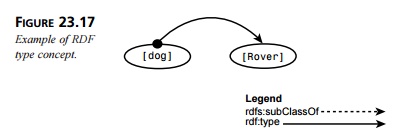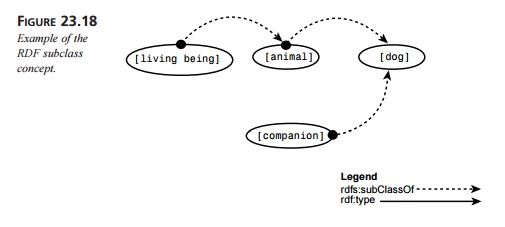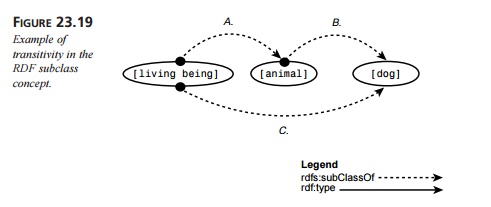Chapter: XML and Web Services : The Semantic Web : RDF for Information Owners
RDF Schema
RDF
Schema
Historically, RDF grew out of
the need to specify a general-purpose mapping between specific bibliographic
solutions using particular vocabularies. Here are some examples:
The W3C Platform for Internet Content Selection (PICS)
The Dublin Core (simple bibliographic data for Web pages)
Site maps, subject taxonomies, thesauruses, and library
classification systems
The W3C Platform for Privacy Protection (P3P)
In this section, we look at
how to use RDF schema to constrain, validate, document, and extend RDF
vocabularies using the RDF typing system.
Validity
in RDF Schema
RDF schema meets its
requirement for generality by being a vocabulary for vocabularies (just as XML
and SGML are languages for defining languages). We might imagine our teacher,
still at the blackboard, being asked, “How do I know that this statement makes
sense, even if all the words are in the right place?” She might answer,
“Because some words can only be used with other words. Jane can sell books, but
books can’t sell Jane.”
In RDF-speak, unlike general
usage, a vocabulary is not just a
list of words. Rather, an RDF vocabulary may be said to define:
Subject validity (which predicates go with which subjects)
Object validity (which predicates go with which objects)
For example, in the “Jane
sells books” examples, we have a set of resources: [Jane], [sells], and [books]. If we define a schema
against which to check this statement, [Jane] could be the subject in a statement where [sells] is the predicate. This is
sub-ject validity. Likewise [books] could be the object in a statement where [sells] is the predicate (and [Jane] could not). That is object
validity.
RDF schema can define a
vocabulary that accomplishes these validity constraints through what is called
its typing system.
The
RDFS Typing System
To “connect the dots” in the
RDF typing system, we need to cover two concepts:
rdf:type
rdfs:subclassOf
rdf:type enables class/instance
statements to be made. When a resource has a type, the resource is the object in a
statement where the predicate is [rdf:type] and the subject is the type. Figure 23.17 shows
an RDF statement that says that [Rover] is a type of [dog]. Rover can also be said to be an instance of
the class dog, and every statement about the class of dogs can be made about
Rover. However, instances are unique: There is only one Rover—this Rover.

rdfs:subclassOf enables subset/superset
statements to be made. The class is the super-set; the subclass is the subset.
When a resource is a subclass, the resource is the object in a statement where
the predicate is rdfs:subClassOf and the subject is an RDF class.
Figure 23.18 shows that the
class [dog] is a subclass of the class [animal] and that [animal] is a subclass of [living being]. You can also see that, in RDF, a class may be a subclass of more than one
class; the class of dogs may also be a subset of the class of [companion]—a “companion animal” being
(often) a pet.

Class relations are said to
be transitive. If class [dog] is a subclass of the broader
class [animal], and [animal] is a subclass of [living being], then [dog] is also implicitly a subclass of [living being]. Figure 23.19 shows this relationship: There
are not only arcs A and B between [living being] and [animal], and between [animal] and [dog], but also arc C, drawn explicitly between [living being] and [dog]. However, although such implicit arcs are
present in the RDF graph, we generally simplify the pictorial repre-sentation
of class relations to keep the graph less cluttered by leaving them out. A
human can trace the class relations upward or downward, if necessary.

We will look at more
subtleties of classes, subclasses, and typing later when we look in more detail
at the RDF hierarchy.
We now have what we need for
an overview of the RDF class hierarchy. All the predicates in the RDFS typing
system are either rdfs:subClassOf or rdf:type, as is shown in Figure 23.20. (The single exception to this rule
is a use of rdfs:subproperty, discussed later.) The 16 RDF schema resources are divided into
the following
six categories:
Validation
Core
Hierarchy
Documentation
Schema control
Extensibility
Also, each schema resource is
represented by a node.
We will discuss these
categories and their resources, in order, in the remainder of this section
(although validation concepts are divided into two parts).
Validation
We’ll start with
validation—even though it is nearer the bottom of the RDF class hierar-chy than
the top—because that’s the operation many information owners will want to
perform on their data, just as they want a database schema to control the
quality of their RDBMS and they want an XML DTD or XML schema to provide some
level of quality assurance for their data. Recall that there are two forms of
schema validation in RDF: object validity and subject validity. rdfs:domain handles subject validity; rdfs:range handles object validity.

rdfs:domain
rdfs:domain is a type of rdfs:ConstraintProperty. It constrains the classes
of subjects (resources) for which the property is a valid predicate. If a
property has no domain, it can be the predicate of any subject. A property may
have more than one range. If a property has more than one rdfs:domain constraint, it may be the
predicate of subjects that are subclasses of any one or all of the specified
classes.
The range and domain of the rdfs:domain concept are specified only
in a comment, so there is no pictorial representation of rdfs:domain.
rdfs:range
rdfs:range is a type of
rdfs:ConstraintProperty. It constrains the classes of objects (resources) for
which the property is a valid predicate. A property doesn’t have to have a
range. If so, the property can be used as an object in any statement. However,
when imposed, the constrains of rdfs:range are stronger than those imposed by
rdfs:domain. First, a property can have only one range. Second, the domain
(subject) of an rdfs:range predicate must be an rdf:property, and its range
(object) must be an rdfs:Class.
Core
Now that you understand the
key concern of information owners—validation—let’s move to the top of the RDF
class hierarchy.
rdfs:Resource
rdfs:Resource is the root of
the RDF class hierarchy (refer back to Figure 23.8). All things described by
RDF expressions—all nodes and labels in the RDF graph—are instances of
rdfs:Resource. rdfs:Resource is also a class. In fact, rdfs:Resource is a type
of rdfs:Class, and rdfs:Class is a subclass of rdfs:Resource. (Remember, the
RDF graph permits cycles!)
rdf:property
rdf:property represents the
subset of RDF resources that are properties (see Table 23.1). rdf:property is a
type of rdfs:Class and a subclass of rdfs:Resource. rdf:property has the “rdf”
namespace prefix, rather than the “rdfs” prefix, because the RDF model has
implicit properties, even if it lacks a schema.
rdf:type
As you have seen, rdf:type
indicates that a resource is an instance of a specified class. That class must
be an instance of rfds:Class or a subclass of rdfs:Class. This state-ment is
true for the resource that is known as rdfs:Class, which is a type of itself.
(The RDF graph, again, permits loops.)
Like rdf:property, rdf:type
has the “rdf” namespace prefix, rather than the “rdfs” prefix, because the RDF
model has implicit types, even if it lacks a schema.
Class Hierarchy
The class hierarchy in RDF is
set up by with rdfs:class, rdfs:subClassOf, and rdfs:subPropertyOf (and
rdf:type, which we’ve already looked at). Let’s look at these three elements.
rdfs:Class
As you have seen, rdfs:Class is both a type of resource
and a subclass of itself. However, RDF classes are both like and unlike classes
as OO programmers may think of them. RDF classes are like OO classes in that,
through transitivity, they can specify broad-to-specific categories such as
“living being to animal to dog.” RDF classes are unlike OO classes, first,
because they have no methods—they don’t do
anything. (Markup never does.) Second, RDF classes could be called extrinsic rather intrinsic. Instead of defining a class in terms of features
intrinsic to its instances, an RDF schema will define predicates in terms of
the classes of subject or object to which they may be applied, extrinsically.
(This allows testing for subject and object validity.)
Theoretically, URIs
representing HTML documents, dogs, books, databases, and abstract concepts
could all be members of the same class—the class of things that can be
repre-sented by RDF.
rdfs:subClassOf
rdfs:subClassOf is a type of rdf:property. It specifies a
subset/superset relation between classes—a relation that is transitive, as you have seen.
Only instances of the type rdfs:Class may have an rdfs:type property whose value is rdfs:Class. Importantly, a class can never be declared to
be a subclass of itself or any of its own sub-classes. (The RDF Schema
specification cannot express this constraint formally, though it is expressed
in prose.) Therefore, although the RDF graph may contain cycles, the
class/subclass inheritance hierarchy that is a subgraph of the RDF graph
remains a tree, whose nodes are only instances of rdfs:Class. Finally, RDF (unlike most
object-ori-ented programming languages) permits multiple inheritance—that is, a
class may be a subclass of several classes. (It could hardly be otherwise,
because the Semantic Web must permit arbitrary combinations of RDF statements
taken from multiple systems, each of which may have its own inheritance
hierarchy.)
rdfs:subPropertyOf
rdfs:subProperty is a type of rdf:property. It enables properties to be
specialized—a process similar to inheritance, except for properties instead of
classes. Like the subClassOf predicate, subPropertyOf is transitive and forms a hierarchy that is a proper tree, like rdfs:subClassOf. Multiple specializations
are also permitted.
Documentation
Documentation allows
human-readable text to be attached to a resource, either as a label or a
comment. Because the content of the documentation elements is only data, not
state-ments, it does not affect the RDF graph in any way and therefore does not
enable machine understanding of the resource.
rdfs:label
rdfs:label provides for a human-readable
representation of a URI, perhaps for display. The domain (subject) of a label predicate must
be an rdfs:resource. The range (object) must an rdf:literal.
rdfs:comment
rdfs:comment permits human-readable
documentation to be associated with a resource. The domain (subject) of a comment predicate
must be an rdfs:resource. The range (object) must an rdf:literal.
rdfs:seeAlso
rdfs:seeAlso is a cross-reference that
gives more information about a resource. The nature of the information provided is not
defined. The domain (subject) and range (object) of an rdfs:seeAlso predicate must both be rdfs:resource elements.
Schema
Control
rdfs:isDefinedBy is a subproperty of rdfs:seeAlso. It’s URI is meant to be the
address of the RDF Schema for the subject resource. The domain (subject)
and range (object) of an rdfs:isDefinedBy predicate must both be rdfs:resource elements.
General
Constraints
We now turn to the issue of
constraints in general (that is, beyond the constraints on domain and range,
discussed earlier). At this point, there’s one caveat: Because markup doesn’t do anything, RDFS doesn’t say what an
application must do if a constraint is vio-lated. That is up to the
application.
rdfs:ConstraintProperty
rdfs:ConstraintProperty is a subclass of both rdfs:ConstraintResource and rdf:property. Both rdfs:domain and rdfs:range are instances of it.
Extensibility
rdfs:ConstraintResource is a type of rdfs:Class and a type of rdfs:Resource. It is present in the model so that
other constraint properties besides domain and range may be subclassed from it.
Non-Model
Validation
This type of validation is
called “non-model” because expressing the notion that a literal should be
checked for being a literal or that the auto-generated counter for container
children should be derived from the actual number of children is something the
RDF engine would have to do, not the data model.
rdfs:literal
rdfs:literal is a type of rdfs:Class. An rdfs:literal can contain atomic values
such as textual strings. The XML lang attribute can be used to
express the fact that a literal is in a human language, but this information
does not become a statement in the graph.
rdfs:ContainerMembershipProperty
rdfs:ContainerMemberShip is a type of rdfs:class and subclass of rdf:property. Its members are the properties _1, _2, _3, and so on (the order in
which the children of a container appear in the container, under the ord component of the data
model).
Related Topics